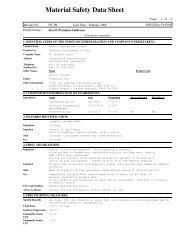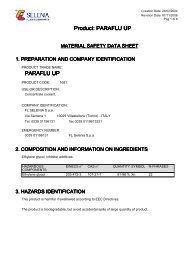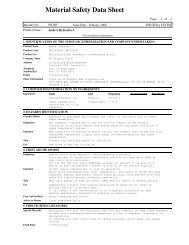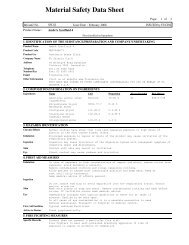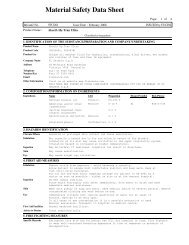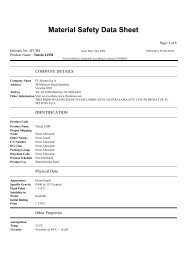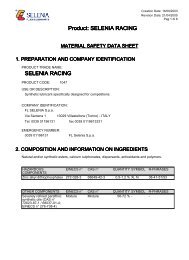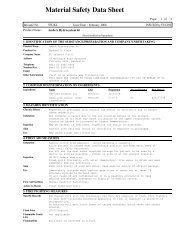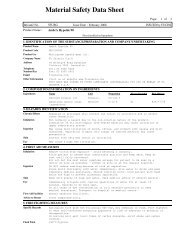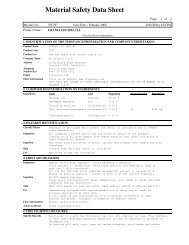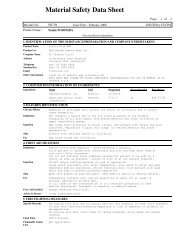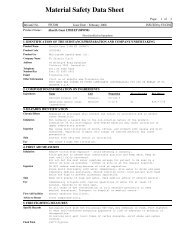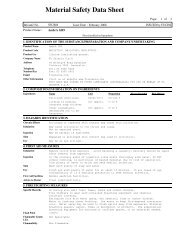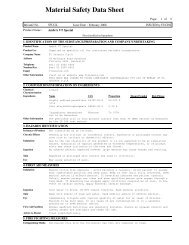Akcela Transaxle - FL Selenia
Akcela Transaxle - FL Selenia
Akcela Transaxle - FL Selenia
Create successful ePaper yourself
Turn your PDF publications into a flip-book with our unique Google optimized e-Paper software.
Material Safety Data Sheet<br />
Page: 1 of<br />
Infosafe No. 5FUG1 Issue Date : February 2008 ISSUED by FUCHS<br />
Product Name :<br />
AkcelA <strong>Transaxle</strong> Fluid<br />
Not classified as hazardous<br />
1. IDENTIFICATION OF THE SUBSTANCE/PREPARATION AND COMPANY/UNDERTAKING<br />
Product Name<br />
Product Code 3111<br />
Product Use<br />
Company Name<br />
Address<br />
Telephone<br />
Number/Fax<br />
Email<br />
Other Information<br />
AkcelA <strong>Transaxle</strong> Fluid<br />
Supplied as a multifunctional lubricant for axle of earth-moving machines.<br />
<strong>FL</strong> <strong>Selenia</strong> S.p.A<br />
49 McIntyre Road Sunshine<br />
Victoria 3020 Australia<br />
Tel: 03 9300 6400<br />
Fax: 03 9300 6401<br />
flselenia.com<br />
Visit us at website www.flselenia.com<br />
THIS MSDS WAS ISSUED BY FUCHS LUBRICANTS (AUSTRALASIA) PTY LTD ON BEHALF OF <strong>FL</strong><br />
SELENIA S.p.A<br />
2. COMPOSITION/INFORMATION ON INGREDIENTS<br />
Ingredients<br />
Name CAS Proportion Hazard Symbol Risk Phrase<br />
Zinc alkyldithiophosphate<br />
68649-42-3<br />
0-10 %<br />
5<br />
Calcium branched chain<br />
alkaryl sulphonate<br />
Highly refined paraffinic Mixture<br />
mineral oil blend<br />
0-10 %<br />
to 100%<br />
3. HAZARDS IDENTIFICATION<br />
Route(s) of Entry<br />
Inhalation<br />
Ingestion<br />
Skin<br />
Eye<br />
4. FIRST AID MEASURES<br />
Inhalation<br />
Ingestion<br />
Skin<br />
Eye<br />
First Aid Facilities<br />
Advice to Doctor<br />
Harmful if swallowed.<br />
Inhalation, skin, ingestion and eyes.<br />
Inhalation of vapour or mists generated by heating, stirring or spraying<br />
can result in headaches and irritation of the throat and nose.<br />
No adverse effects expected however large amounts may cause nausea and vomiting.<br />
Acute oral toxicity is considered to be extremely low. No hazards anticipated from<br />
swallowing small amounts incidental to normal handling conditions.<br />
Generally non-irritant on incidental contact. Excessive or prolonged contact may<br />
give rise to slight irritation.<br />
Product may cause slight to moderate irritation to the eyes.<br />
Remove victim from exposure - avoid becoming a casualty. Seek medical attention.<br />
DO NOT induce vomiting because of risk of aspiration. Seek medical attention.<br />
Wash with plenty of soap and water. Remove contaminated clothing and wash before<br />
re-use. If irritation occurs seek medical advice.<br />
Immediately irrigate with copious quantity of water for at least 15 minutes.<br />
Eyelids to be held open. Seek medical advice if effects persist.<br />
Typical washroom facilities.<br />
Treat symptomatically.<br />
5. FIRE FIGHTING MEASURES<br />
Extinguishing Media<br />
Specific Hazards<br />
Use foam. carbon dioxide, Dry chemical powder water spray, Do not use water in a<br />
jet. Use water jet to keep containers cool.<br />
Hazardous Combustion products include oxides of carbon, nitrogen, phosphorous and sulphur as<br />
Combustion Products well as unidentified organic and inorganic compounds.<br />
Protective Equipment Full protective clothing and self-contained breathing apparatus.<br />
Flash Point More than 200°C
Material Safety Data Sheet<br />
Page: 2 of<br />
Infosafe No. 5FUG1 Issue Date : February 2008 ISSUED by FUCHS<br />
Product Name :<br />
Flammable Limits<br />
LEL<br />
Flammability<br />
Explosion Data<br />
AkcelA <strong>Transaxle</strong> Fluid<br />
Not available<br />
NON -Combustible liquid.<br />
Not available<br />
6. ACCIDENTAL RELEASE MEASURES<br />
Spills & Disposal<br />
Not classified as hazardous<br />
Slippery when spilt. Avoid accidents, clean up immediately.<br />
Personal Precautions Avoid contact with skin and eyes.<br />
Personal Protection<br />
Environmental<br />
Precautions<br />
Other Information<br />
7. HANDLING AND STORAGE<br />
Handling<br />
Storage<br />
Packaging<br />
Other Information<br />
Wear protective clothing previously specified for normal operations.<br />
Prevent contamination of soil and water. Inform local authorities if this cannot<br />
be prevented.<br />
In event of large spill: Collect and seal in properly labelled drums for disposal.<br />
In the event of a small spill: Use absorbent (soil or sand, sawdust, inert<br />
material, vermiculite). Observe local regulations.<br />
Avoid prolonged or repeated contact with skin and eyes . Ventilate workplace in<br />
such a way that the Occupational Exposure Limit (OEL) is not exceeded. Ensure a<br />
high level of personal hygiene is maintained when using this product. That is;<br />
always wash hands before eating, drinking, smoking or using the toilet<br />
Store in a well ventilated place away from ignition sources, oxidising agents,<br />
foodstuffs and clothing. Keep containers closed when not in use.<br />
Store under cover in the original container securely closed away from heat and<br />
sources of ignition. Do not store in open air.<br />
Hazardous Substance labelling:<br />
Hazard category: Xn Harmful<br />
Risk phrase - R22: Harmful if swallowed.<br />
R36/38 Irritating to eyes and skin<br />
Safety Phrase - S2 Keep out of reach of children.<br />
S36/37/39 Wear suitable protective clothing, gloves and eye/face<br />
protection.<br />
S44 If you are unwell contact a doctor.<br />
Avoid contact with strong acids and oxidising agents.<br />
8. EXPOSURE CONTROLS/PERSONAL PROTECTION<br />
National Exposure<br />
Standards<br />
Respiratory<br />
Protection<br />
The recommended exposure limits (ACGIH) for oil mists are:<br />
TLV/TWA (8 h) - 5 mg/m3<br />
TLV/STEL - 10 mg/m3<br />
Not normally required. If oil mist cannot be controlled, a respirator fitted with<br />
an organic vapour cartridge combined with a particulate pre-filter should be used.<br />
5<br />
Eye Protection<br />
Hand Protection<br />
Personal Protective<br />
Equipment<br />
Body Protection<br />
Eng. Controls<br />
Wear chemical mono-goggles or full face shield if splashes are likely to occur.<br />
Neoprene or nitrile rubber gloves.<br />
Overalls or similar protective apparel. Safety glasses,goggles or faceshield as<br />
appropriate. Rubber gloves. Always work in a well ventilated area.<br />
Avoid skin and eye contact and inhalation of vapour and mist.<br />
Wear overalls, safety shoes, chemical goggles and impervious gloves.<br />
Use with adequate ventilation. If inhalation risk exists wear organic<br />
vapour/particulate respirator meeting the requirements of AS/NZS 1715 and<br />
AS/NZS 1716.<br />
Always wash hands before eating, smoking, drinking or using the toilet.<br />
Wash contaminated clothing and other protective equipment before storing<br />
or re-using.<br />
Wear overalls to minimise contamination of personal clothing. Launder overalls and<br />
undergarments regularly. Wash contaminated clothing and protective equipment<br />
before storing/re-using.<br />
Must be sufficient to prevent breathing of vapour. Maintain concentration below<br />
recommended exposure limit.<br />
Vapour at elevated temperatures heavier than air - prevent concentration in
Material Safety Data Sheet<br />
Page: 3 of<br />
Infosafe No. 5FUG1 Issue Date : February 2008 ISSUED by FUCHS<br />
Product Name :<br />
Technical Protective<br />
Measures<br />
AkcelA <strong>Transaxle</strong> Fluid<br />
Not classified as hazardous<br />
hollows or sumps.<br />
DO NOT enter confined spaces where vapour may have collected.<br />
Keep containers closed when not in use.<br />
Avoid production and diffusion of mist and aereosol with utilisation of localised<br />
ventilation/aspiration or other required precautions. If necessary, adopt all<br />
required precaution to avoid product immission in environment.<br />
9. PHYSICAL AND CHEMICAL PROPERTIES<br />
Appearance<br />
Viscous liquid.<br />
Boiling Point More than 300°C<br />
Solubility in Water<br />
Specific Gravity<br />
(H2O=1)<br />
Vapour Pressure<br />
Vapour Density<br />
(Air=1)<br />
Physical State<br />
Insoluble<br />
0.900 @ 15°C<br />
Not available<br />
Not available<br />
Liquid.<br />
Viscosity 25 cSt @ 100°C<br />
206 cSt @ 40°C<br />
Volatile Component Not available<br />
Flash Point More than 200°C<br />
Flammability<br />
Flammable Limits<br />
LEL<br />
Explosion Properties<br />
Other Information<br />
NON -Combustible liquid.<br />
Not available<br />
Not available<br />
10. STABILITY AND REACTIVITY<br />
Materials to Avoid<br />
Hazardous Reaction<br />
Conditions to Avoid<br />
Nitrogen oxides and oxides of carbon and sulphur will be evolved in a fire.<br />
The product is stable under normal conditions of use.<br />
Avoid contact with strong acids, and strong oxidising agents.<br />
Avoid contact with strong acids, bases and oxidising agents.<br />
Reacts with acids and strong oxidising agents.<br />
Heat<br />
It is suggested to avoid temperatures above flash point.<br />
11. TOXICOLOGICAL INFORMATION<br />
Toxicology<br />
Information<br />
Inhalation<br />
Ingestion<br />
Skin<br />
Eye<br />
12. ECOLOGICAL INFORMATION<br />
Information on<br />
Ecological Effects<br />
No LD50 data available for product.<br />
However, for Triethanolamine (10% v/v):<br />
Oral LD50 (rat) : 4190 - 11260 mg/kg<br />
Inhalation of vapour or mists generated by heating, stirring or spraying<br />
can result in headaches and irritation of the throat and nose.<br />
No adverse effects expected however large amounts may cause nausea and vomiting.<br />
Acute oral toxicity is considered to be extremely low. No hazards anticipated from<br />
swallowing small amounts incidental to normal handling conditions.<br />
Generally non-irritant on incidental contact. Excessive or prolonged contact may<br />
give rise to slight irritation.<br />
Product may cause slight to moderate irritation to the eyes.<br />
This product is not classified dangerous for the environment, but it is considered<br />
not readily biodegradable.<br />
Given its physical and chemical characteristics, the product shows weak tendency<br />
to evaporation, little mobility in the ground and it can be adsorbed from soil.<br />
The product is not soluble in water. In case of large spills, it is a potential<br />
source of soil, watercourse and graoundwater pollution.<br />
Some product components are harmful to aquatic organisms and with long-term<br />
adverse effects in the aquatic environment.<br />
5
Material Safety Data Sheet<br />
Page: 4 of<br />
Infosafe No. 5FUG1 Issue Date : February 2008 ISSUED by FUCHS<br />
Product Name :<br />
Known Harmful<br />
Effects on the<br />
Environment<br />
AkcelA <strong>Transaxle</strong> Fluid<br />
13. DISPOSAL CONSIDERATIONS<br />
Not classified as hazardous<br />
For Triethanolamine:<br />
Toxicity to fish:<br />
LC 50 - >5000 mg/L 24h<br />
EC 50 - 1390mg/L 24h<br />
Low toxicity to aquatic organisms.<br />
Note: Triethanolamine is present as a minor component (10% v/v)<br />
Waste Disposal Refer to State Land Waste Management Authority. (Victoria:MMBW (03)615 6099)<br />
Contain - prevent contamination of drains and waterways. Do not dispose into the<br />
environment, in drains or in water courses.<br />
14. TRANSPORT INFORMATION<br />
Storage and<br />
Transport<br />
15. REGULATORY INFORMATION<br />
Risk Phrase<br />
Safety Phrase<br />
Poisons Schedule<br />
Packaging &<br />
Labelling<br />
Hazard Category<br />
16. OTHER INFORMATION<br />
Not classified as a Dangerous Good according to the Australian Code for the<br />
Transport of Dangerous Goods by Road and Rail.<br />
Not classified as dangerous.<br />
R22 Harmful if swallowed.<br />
S13 Keep away from food, drink and animal feeding stuffs.<br />
S2 Keep out of reach of children.<br />
S24/25 Avoid contact with skin and eyes.<br />
S46 If swallowed, seek medical advice immediately and show this container or<br />
label.<br />
S5<br />
Hazardous Substance labelling:<br />
Hazard category: Xn Harmful<br />
Risk phrase - R22: Harmful if swallowed.<br />
R36/38 Irritating to eyes and skin<br />
Safety Phrase - S2 Keep out of reach of children.<br />
S36/37/39 Wear suitable protective clothing, gloves and eye/face<br />
protection.<br />
S44 If you are unwell contact a doctor.<br />
Harmful<br />
Contact Person/Point Laboratory Manager (03) 9300 6400<br />
Research & Development Chemist (03) 9300 6400<br />
This information was prepared in good faith from the best information available at<br />
the time of issue. It is based on the present level of research and to this extent<br />
we believe it is accurate. However, no guarantee of accuracy is made or implied<br />
and since conditions of use are beyond our control, all information relevant to<br />
usage is offered without warranty. The manufacturer will not be held responsible<br />
for any unauthorosed use of this information or for any modified or altered<br />
versions.<br />
If you are an employer it is your duty to tell your employees, and any others that<br />
may be affected, of any hazards described in this sheet and of any precautions<br />
that should be taken.<br />
Material Safety Data Sheets are updated frequently. Please ensure you have a<br />
current copy.<br />
References * NOHSC:2011 National Code of Practice for the Preparation of Material Safety Data<br />
Sheets<br />
* NOHSC:1008 Approved Criteria for Classifying Hazardous Substances<br />
* NOHSC:10005 List of Designated Hazardous Substances<br />
* NOHSC:1005 Control of Workplace Hazardous Substances, National Model Regulations<br />
* NOHSC:2007 Control of Workplace Hazardous Substances, National Code of Practice<br />
* NOHSC:1003 Exposure Standards for Atmospheric Contaminants in the Occupational<br />
Environment, National Exposure Standards<br />
* NOHSC:3008 Exposure Standards for Atmospheric Contaminants in the Occupational<br />
Environment, Guidance Note<br />
* NOHSC:1015 Storage and Handling of Workplace Dangerous Goods, National<br />
5
Material Safety Data Sheet<br />
Page: 5 of<br />
Infosafe No. 5FUG1 Issue Date : February 2008 ISSUED by FUCHS<br />
Product Name :<br />
Last Change<br />
Poisons Schedule<br />
Hazard Category<br />
AkcelA <strong>Transaxle</strong> Fluid<br />
Not classified as hazardous<br />
Standard<br />
* NOHSC:2017 Storage and Handling of Workplace Dangerous Goods, National Code of<br />
Practice<br />
* SUSDP, Standard for the Uniform Scheduling of Drugs and Poisons<br />
* ADG, Australian Dangerous Goods Code<br />
* MSDS of component materials<br />
Supersedes issue date: First issue.<br />
Reason/s for revision: Alignment to NOHSC requiurements.<br />
S5<br />
Harmful<br />
...End Of MSDS...<br />
5



